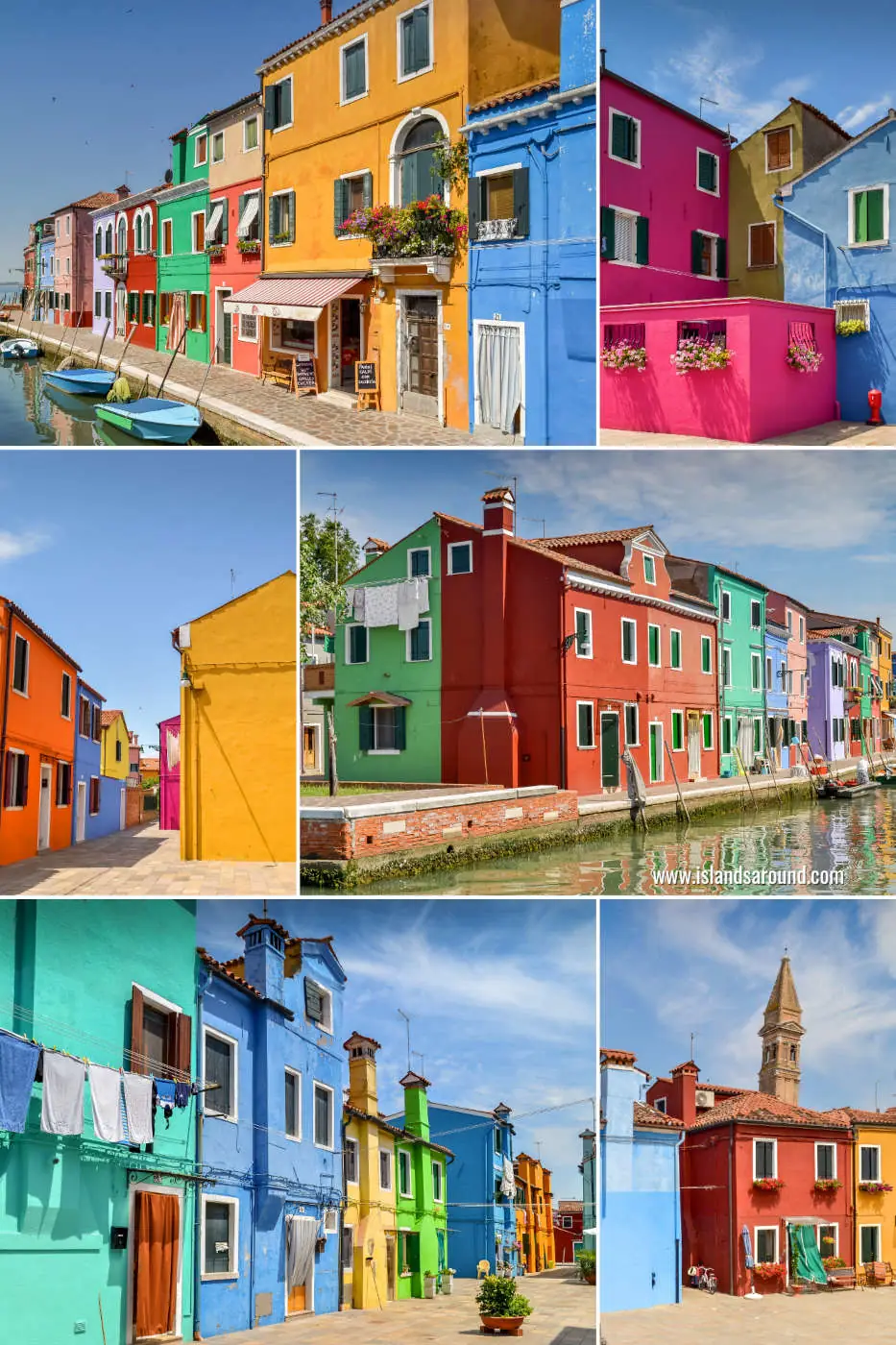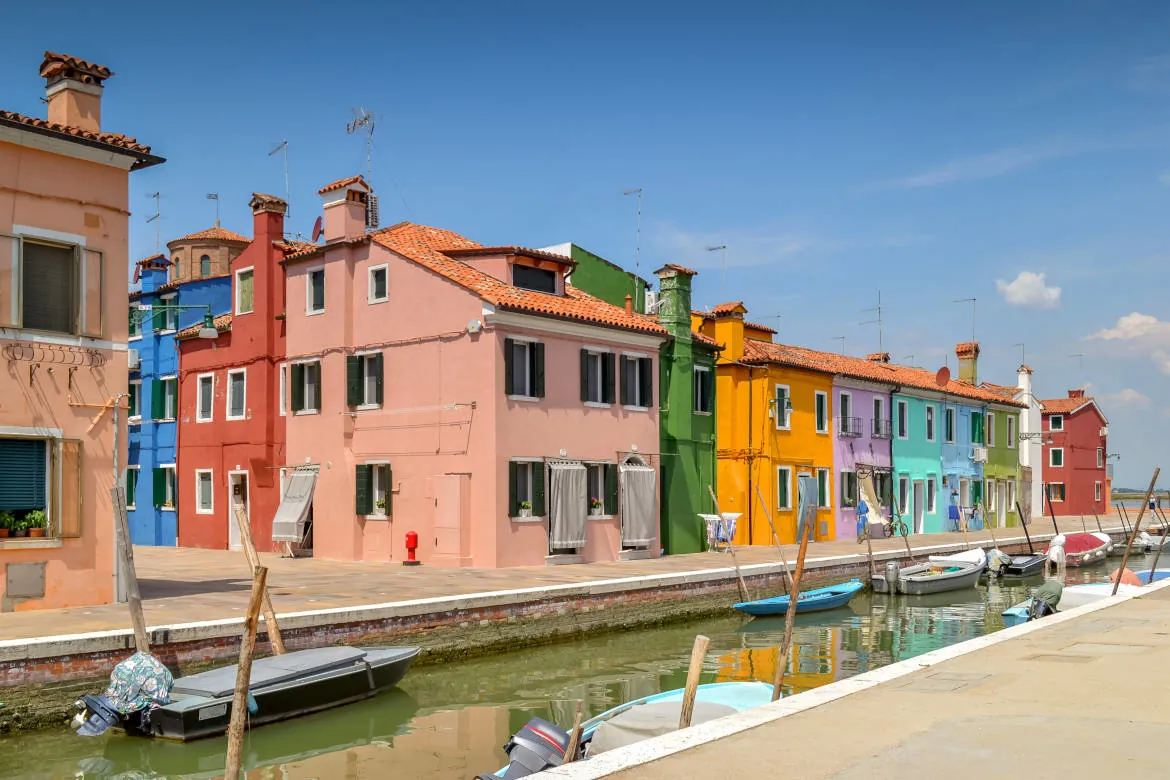Nestled in the Venetian Lagoon, Burano is known for its vividly painted houses, intricate lace-making traditions, and tranquil canals.
A short vaporetto ride from Venice, the island has long been a retreat for those seeking a different pace of life. Yet, beyond its striking façades and quiet waterways lies a history shaped by fishermen, artisans, and centuries-old customs that endure to this day.
Table of Contents
A Kaleidoscope of Colors
Burano’s houses, painted in an array of bright colors, create a striking contrast against the muted tones of the lagoon. This is no accident of whimsy. According to local accounts, the practice began as a practical solution for fishermen, who painted their homes in vivid hues to make them easily identifiable through the thick morning fog.
Today, the tradition persists under municipal regulations that dictate the colors permissible for each building, ensuring the island retains its distinctive aesthetic. The effect is more than visual. The colors shape the island’s identity, distinguishing Burano from other Venetian settlements and reinforcing a sense of place rooted in its maritime heritage.
The color-coded homes also serve as a visual record of Burano’s past, linking present-day residents to generations of fishermen before them. Those eager to capture the most striking views should visit in the early morning or late afternoon when the sunlight accentuates the contrast of the painted houses against the shimmering lagoon.

The Lacemaking Legacy
Lace-making is another pillar of Burano’s cultural identity. The art form, introduced in the 16th century, quickly became sought after in European courts. At its height, Burano’s lace rivaled Venetian glass in value, with delicate, handcrafted patterns adorning the garments of royalty and clergy alike.
The decline of the lace industry came with industrialization, as machine-made lace rendered the labor-intensive craft increasingly unsustainable. Efforts to preserve the tradition continue at the Museo del Merletto (Lace Museum), where skilled artisans demonstrate techniques passed down through generations.
Although few practitioners remain, Burano’s lace endures as a symbol of the island’s artistic legacy. For those wishing to take home a piece of authentic lace, it is important to distinguish between handmade and machine-produced items, as many shops now sell inexpensive imitations. Seek out workshops where artisans can be seen at work, ensuring the lace is genuinely crafted in the traditional Burano style.
Burano’s Culinary Secrets
Burano’s culinary landscape is shaped by its proximity to the lagoon, with fresh seafood and simple, rustic recipes forming the backbone of local cuisine.
Notable Dishes
- Risotto de Gò: A dish made with goby fish, a species native to the Venetian Lagoon. Slow-cooked with rice, it exemplifies the resourceful approach to cooking that defines Burano’s gastronomy.
- Bussolà and Esse Biscuits: Rich, egg-based cookies originally baked by fishermen’s wives as provisions for long journeys at sea. Their dense, buttery texture remains a staple of Burano’s culinary tradition.
- Sarde in Saor: A sweet-and-sour dish of marinated sardines, onions, pine nuts, and raisins, reflecting the island’s historical ties to Venetian spice traders.
While restaurants catering to tourists are plentiful, those in search of an authentic experience should seek out family-run establishments, such as Trattoria al Gatto Nero, known for its fresh seafood and commitment to local ingredients. Al Raspo de Ua is another notable eatery, offering traditional Burano flavors in a quiet setting.
Nature and Tranquility
Beyond Burano’s colorful center lies Mazzorbo, a quieter, less-frequented island connected by a wooden footbridge. Mazzorbo’s vineyards, particularly at Venissa Wine Estate, offer a glimpse into an almost forgotten aspect of Venetian agriculture, where the rare Dorona grape is cultivated for a unique variety of white wine.
The surrounding lagoon, with its network of salt marshes and shallow waters, is a haven for birdlife. Herons, egrets, and flamingos are among the species that make their home here, offering an alternative to the more structured sights of Burano’s main piazza.
For a different perspective of the lagoon, consider taking a traditional bragozzo, a wooden fishing boat, to explore the hidden channels and lesser-known islets of the area. Some tours offer insights into local fishing traditions, further connecting visitors with Burano’s maritime roots.

Quirky Legends and Local Oddities
Burano has its share of peculiarities, including its own leaning tower—the Campanile di San Martino, whose pronounced tilt is the result of centuries of subsidence in the soft ground beneath it. Another curiosity is the Casa di Bepi Suà, a house painted in a patchwork of geometric shapes and vibrant colors.
Its former owner, Bepi, was known for screening films for local children in the adjacent square, earning him a place in Burano’s collective memory. This Italian island also has an unusual tradition linked to its lace-making history.
According to legend, a fisherman, resisting the enchantment of a siren’s song, was rewarded with a veil of intricate lace, which he gifted to his betrothed. This mythical story reinforces the romantic allure of Burano lace, adding a touch of folklore to the island’s artistic legacy.
Visitors in winter experience a vastly different Burano—one that is eerily quiet, with mist rolling in from the lagoon. The near-absence of tourists transforms the island into a place of solitude, where the sound of lapping water and distant church bells replace the chatter of summer crowds.
How to Get to Burano
Burano is accessible via the ACTV Vaporetto Line 12, departing from Fondamente Nove in Venice every 30–40 minutes. The journey takes approximately 45 minutes, passing through Murano and Mazzorbo before arriving at Burano’s shores. Private water taxis offer a more direct, though costly, alternative.
Some visitors opt for guided boat tours, which combine visits to multiple islands, including Murano and Torcello. For those seeking a more immersive experience, early morning departures allow for a quieter visit before the midday influx of tourists. Staying overnight on the island is rare but possible, with small guesthouses offering a chance to experience Burano after the day-trippers have left.

